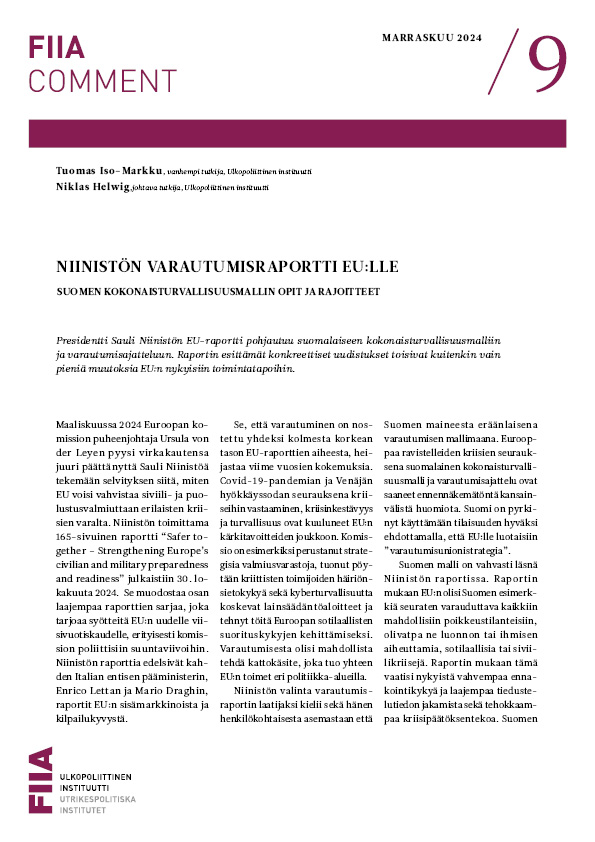For a second time since the failed attempt of last November, Ukraine is gearing up to sign an Association Agreement with the European Union – this time on 27 June. The Ukrainians have chosen their domestic development path, which is closely tied to the country’s foreign policy orientation.
This time, Ukraine has a leadership that seems to be truly committed to the European orientation and domestic reforms, and has a clear mandate from the population to follow that course. The country has lost part of its territory, Crimea, and is struggling to regain control over some easternmost regions where violent conflict continues. Yet, apart from these regions, the crisis has served to make Ukraine more united, and has strengthened the bottom-up demand to build a functioning European state.
Russia is blaming the EU for having forced Ukraine to choose between east and west – a claim that has recently been echoed by some European politicians. It is worth remembering that the EU never imposed anything on Ukraine, but has responded to the demands of the Ukrainians, always offering less than the latter requested. The Association Agreement, which includes a so-called Deep and Comprehensive Free Trade Agreement (DCFTA), is the maximum that the EU has (so far) been able to come up with in response to Ukraine’s requests for a closer relationship.
More importantly, the fact is that Ukraine has to choose, and it wants to choose Europe, as the clear victory of Petro Poroshenko in the presidential elections of 25 May confirmed. The EU and the Eurasian Union represent two fundamentally different political systems – democracy and authoritarianism – and the rules and even the technical standards that govern the respective economies are also strikingly divergent.
The European choice should not, of course, imply cutting ties in the other direction. The differences between the two political and economic models do not preclude EU member states and Russia from conducting cooperative political relations and extensive trade. This is what Ukraine is aiming at, too. The EU and Russia have started to discuss trade relations between the Eurasian Economic Union and countries that sign the DCFTA. These talks need to continue, and they require political will on both sides to reach pragmatic solutions.
What the EU still lacks is a real strategy for Ukraine and other Eastern neighbours that pursue EU integration as their top priority, namely Georgia and Moldova, which are set to sign similar agreements on 27 June. The Association Agreement is not a satisfactory solution in the longer term, as it requires the extensive adoption of EU norms by the partner country without offering the perspective of full membership. The question of the future shape of the EU’s relationship to these countries has thus far remained unanswered.
Such a strategy is unlikely to emerge in the coming years; the EU is too divided over Russia and the Eastern neighbourhood. The rise of Russia-friendly populist parties in the European Parliament elections, although having no direct effect on EU foreign policy, has made the task no easier.
Hence, the EU is now even more unlikely to offer Ukraine the membership perspective that the latter craves. The unresolved separatist conflict in eastern Ukraine provides another reason for the EU to put this question aside, but even without it, the Union has no appetite to discuss further enlargement. One can only hope that both sides, the EU and Ukraine, will focus on bringing about real change on the ground rather than wasting time on frustrating debates over enlargement.
The EU is also unlikely to agree on a common assessment of the Russian threat. On the surface, there is a shared understanding that the European security architecture has been seriously damaged by the annexation of Crimea and Russian support for the separatists in east Ukraine. Yet there have been obvious disagreements among EU member states as to what extent the EU should make an effort to confront Russia over Ukraine. The West has struggled to define a common response and has failed to go beyond condemnatory rhetoric and largely symbolic sanctions.
Many Europeans would not mind leaving Ukraine to the Russian sphere of interest and are not ready to bear any significant costs in order to prevent this from happening against the will of the Ukrainians. Some might be ready to negotiate a compromise, accommodating Russian proposals for a ‘federal’ and neutral Ukraine. However, while it is obviously necessary to involve Russia in discussions over Ukraine’s future, any attempt to impose a Russian-inspired solution for Ukraine would likely provoke further protest inside the country, and would be suicidal for any Ukrainian leader – as was the case for Viktor Yanukovych.
Looking ahead, the tensions over and inside Ukraine are set to continue. The Ukrainians will not give up their European choice. Their previous leaders showed little capability to actually deliver the necessary reforms, and it remains to be seen whether the new leadership will prove more adept in this regard. The reforms will be painful, and the economy is in recession, with a 6% fall in real GDP expected for this year according to the Economist Intelligence Unit.
Russia cannot attain the goal of tying Ukraine to its sphere of influence due to resistance by the Ukrainians, but it can continue to destabilize the country and undermine its European-oriented agenda. The EU will support Ukraine’s domestic reforms, but will not give the country a membership perspective in the next few years and will do little to stop Russia’s efforts to destabilize the country. Both the EU and Russia are weakened by the confrontation, to say nothing of Ukraine. In essence, this is a battle between two political and societal models, with Ukraine as the current hot spot.









